Idaho targets the concentration and total load of solids and phosphorus in hatchery effluent water
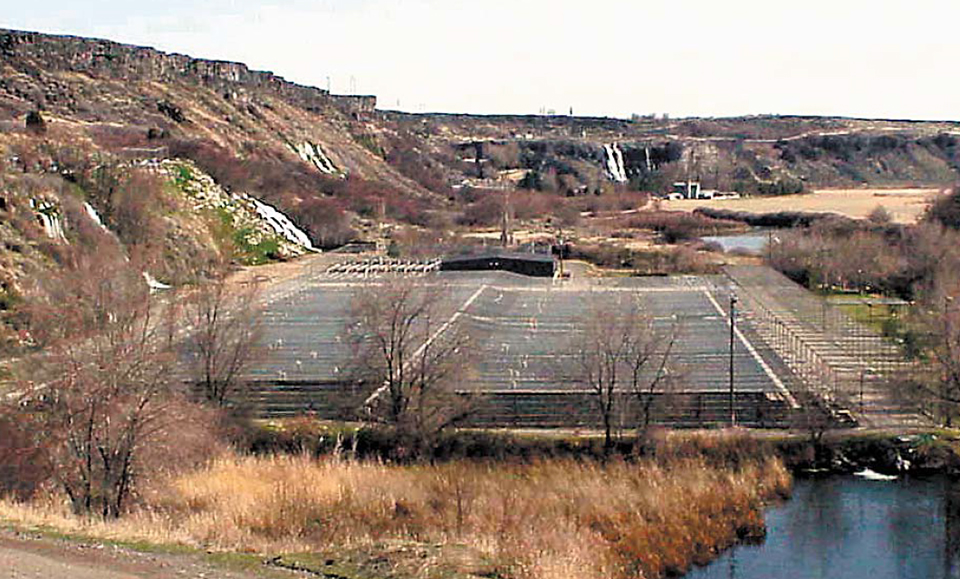
The first legislation to regulate the levels of enriching nutrients in effluents from fish farms was enacted by Denmark in April 1989. These laws were targeted toward trout farms, which utilize river water by diverting it into earthen raceways and returning it to the river after it is used. Although the farms do not consume water, they alter its nutrient load by adding phosphorus, nitrogen, and particulate matter. These enriching nutrients stimulate algae and plant growth, lowering river water quality. In Denmark, several farms are often located along the same river, each contributing nutrients to the total load of the river.
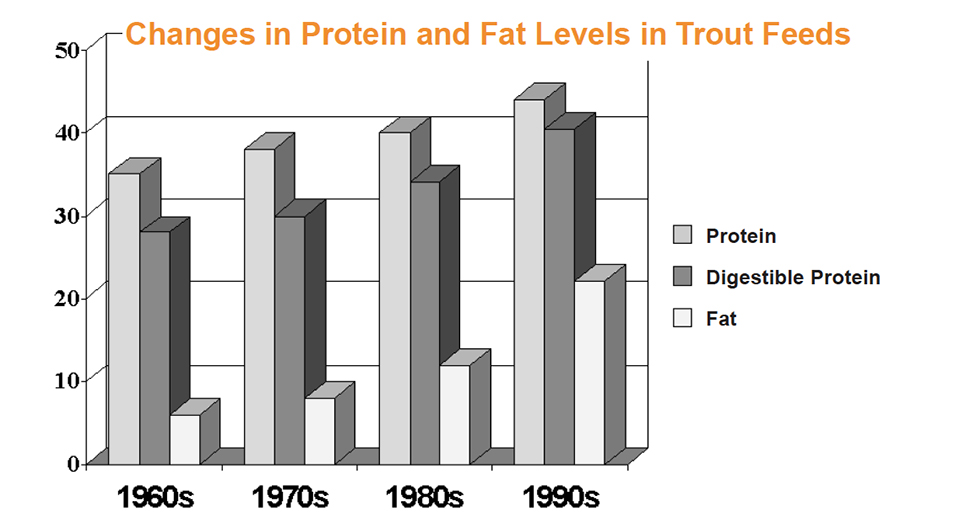
Denmark’s approach to regulation of water quality discharged from trout farms was to establish limits on trout feeds, i.e., the nutrient and energy content, and feed conversion ratios. Coupled to these limits were restrictions on the quantity of trout feed that each farm could purchase. The effect of these regulations on feeds was dramatic. Feeds had to be efficient, high in energy, and low in phosphorus. Consequently, feed manufacturers were unable to use many low-cost feed ingredients, because they contained too much ash (phosphorus), or because the digestible energy or digestible protein content was too low.
Denmark lowered maximum feed phosphorus level in fractions, eventually to 1.0 percent of the feed on January 1, 1992. Feed conversion ratio limits were also lowered in fractions, to a level of 1.0, meaning that for each kg of feed fed to trout, a kg of gain was expected. Nitrogen content was reduced to 8 percent maximum (50 percent maximum crude protein). Gross dietary energy levels were also specified, with a gradual increase in dietary energy density.
These restrictions have transformed salmonid feeds in Denmark, and by extension, in all of Europe. Over the past 20 years, dietary lipid levels have increased dramatically (to meet specified dietary gross energy restrictions), and although total feed protein levels have not changed dramatically, the level of digestible protein has gradually increased (Fig. 1). Restrictions on dust (fines) within salmon and trout feed to a maximum of 1 percent, plus the need to increase dietary energy (thus lipid) levels led to the exclusive use of cooking-extrusion as the manufacturing method of choice.
Regulation of water quality in the United States
In the United States, regulation of water quality is overseen by a federal agency (Environmental Protection Agency), but responsibility for monitoring and compliance is held by individual states. Decisions concerning the effect of fish farms on the freshwater environment are, in part, dependent on two factors: (1) nutrient loads in effluent water; and (2) the quality of the stream, river or lake into which the effluent is discharged. After four years of development, Idaho became the first state in the United States to implement regulations for fish farms in September 1999.
The Idaho trout farming industry
Fortunately, Idaho did not choose to follow the example of Denmark and Europe by micromanaging the formulation and production of fish feeds. Rather, Idaho’s regulations target the concentration and total load of solids and phosphorus in hatchery effluent water. It is up to the farmers (and feed producers) to comply with the limits using any combination of water management, loading density, feeding level, and feed formulation they choose. As long as they are in compliance with the content of phosphorus and solids in the water leaving their farms, what they do on their farms is their business, not that of the regulators.
Idaho trout farming is similar to European freshwater farming systems, except that spring water is used. In Idaho, the first commercial trout farm was started in 1909, near Twin Falls. This area contains many suitable trout farm sites supplied with abundant, constant temperature (14.5 C) spring water from the Eastern Snake River Aquifer, over 23 cubic meters per second in flow. In Idaho trout farms, spring water flows by gravity through a series of raceways, each usually no more than 30 to 40 meters long, with five to seven raceways receiving water in series. Rearing density varies with water quality, which is higher in upper raceways than in lower raceways. Typical rearing densities are 1.8 kg per liter per minute water flow (15 pounds per gallons per minute) in raceways receiving first-use water, and up to 9.6 kilograms per liters per minute (80 pounds per gallons per minute) when productions from all raceways in a series are combined.
Idaho trout farmers use several approaches to comply with discharge regulations. Quiescent zones are used to provide areas where particulate matter can settle without being re-suspended by the activity of fish. Material that settles is removed by pumps, and conveyed to off-line ponds for further settling. Some farms remove the settled material and apply it to farmland. Others mix it with straw and produce compost for garden application. The key elements, as far as water quality is concerned, are the quiescent zone and the frequency with which material is removed, which control the extent of microbial release of bound phosphorus.
Low-pollution feeds for Idaho
Feed is the source of enriching nutrients in rainbow trout farming, and most efforts to lower pollution from trout farms involve modifications of feeds. The approach taken in Europe has resulted in very simple feed formulations: fishmeal, plant proteins (such as corn gluten meal), fish oil, corn or wheat starch (gelatinized), plus vitamin and mineral premixes. Alternate feed ingredients can be used, but the list of possible alternatives is short. Feed ingredients must be high in protein, low in phosphorus, and very digestible. This eliminates many rendered products, such as poultry by-product meal and high-ash fishmeals. High-ash fishmeals, such as those produced from menhaden or seafood processing (filleting) waste, contain higher amounts of bone than fishmeals made from anchovy, herring, capelin or sand eel. Bone is primarily composed of calcium phosphate, and use of high-ash (bone) fishmeals adds too much phosphorus to feed formulations to meet the 1 percent total phosphorus limit.
Modification of feed formulations in Idaho have focused on three areas thus far: (1) refining dietary phosphorus requirement estimates; (2) measuring apparent digestibility coefficients for phosphorus in feed ingredients, using rainbow trout; and (3) modifying the phosphorus content and availability of feed ingredients and feed formulations.
Phosphorus requirement studies
With respect to making more precise estimations of phosphorus requirements for all life stages of salmon and trout, the first area of investigation compared response variables to dietary phosphorus intake in fish. Various physiological measures have been used in dietary phosphorus requirement studies in fish, including whole body phosphorus level, bone ash content, and bone calcium and phosphorus content.
Research showed that the level of phosphorus in skin and scales is a more accurate indicator of phosphorus status in trout than is whole body level. Even more accurate and rapid is the content of phosphorus in trout urine. Urinary phosphorus content is negligible at low dietary intake levels, but increases very rapidly once an intake threshold was reached. Advantages of this method are that it can be completed in less than one week and that it can be used on large fish. Conventional feeding studies take many months to complete, especially with large fish. Using various approaches and taking into account the phosphorus status of the fish, new estimates were made for small fish, grow-out fish, and broodstock.
Small trout were found to have a higher dietary phosphorus requirement than large trout, and trout feeds are now formulated accordingly. Sub-optimal levels of phosphorus in broodstock diets decreased growth rate, but did not affect fertility, egg hatchability or overall egg viability. Fecundity, expressed as number of eggs per kilogram of broodstock, increased when the fish were fed very low phosphorus feeds.
In addition, it was shown that very low levels of phosphorus could be fed during the final month or two of the growout stage in trout farming without decreasing growth rates. The fish utilized stored phosphorus reserves from their skeleton and other hard tissues to supply their needs for growth. These types of diets are sometimes referred to as “finishing diets,” and are suited to trout farming in Idaho, where production and harvest schedules are very predictable.
Phosphorus retention studies
A second approach to phosphorus reduction has been to increase the level of available phosphorus in feeds to increase the percentage utilized by the fish. In trout feeds used prior to the emergence of pollution as a regulatory issue, material balance studies showed that about half of the total phosphorus was indigestible and passed through the gastrointestinal tract as feces. Of the phosphorus that was absorbed by the fish, about half was excreted in urine as soluble phosphorus, which is nearly impossible to remove from effluents. Thus, fish retained only about 25 percent of dietary phosphorus. The balance was excreted as feces (insoluble phosphorus) or urine (soluble phosphorus).
Today’s feeds exhibit much higher phosphorus retention by fish, between 50 percent and 60 percent. This is the result of two main changes: (1) total feed phosphorus content was reduced; and (2) available phosphorus content was adjusted very close to levels required by the fish.
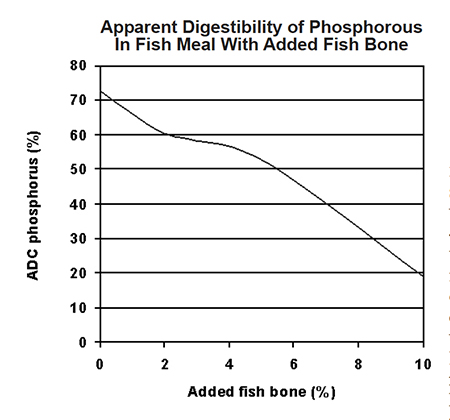
Alternate feed ingredients, such as wheat gluten and soy protein concentrate, have been evaluated as partial substitutes for fishmeal in trout feed formulations. These ingredients contain lower levels of phosphorus than does fishmeal, and phosphorus digestibility is similar to that in fishmeal. In theory, if a feed formulator knew the digestibility coefficients for phosphorus in common feed ingredients, the digestibility of phosphorus in a feed mixture could be calculated. Underlying this approach is the assumption that phosphorus digestibility coefficients are additive. For some feed formulations, this appears to be true, but for others, research has demonstrated that antagonistic interactions interfere with this ideal situation.
This problem was the cause of differing results between studies when researchers first began measuring the apparent digestibility of phosphorus in fishmeal. Subsequently, removing bone and adding it back at increasing levels demonstrated a relationship between the quantity of fish bone in fishmeal and the apparent digestibility of phosphorus. Aclear, negative relationship between the percentage of fish bones in fishmeal and the apparent digestibility coefficient of phosphorus was found, with values ranging from over 70 percent in low-bone fishmeal to under 25 percent in high-bone fishmeal (Fig. 2). Once this relationship was demonstrated, and the underlying mechanisms were identified, steps were undertaken to lower the bone content of fishmeal used in low-pollution feeds.
Three approaches were employed to lower the bone content of fishmeal:
- Screening fishmeal after it was dried but before it was ground to a fine powder.
- Mechanically deboning seafood fillet waste prior to making fishmeal.
- Using air-classification to remove bone particles in dry meals.
Each of these approaches has been used to upgrade fishmeal, and the results on total phosphorus content and apparent digestibility coefficients of phosphorus have been positive.
Feed additives and phosphorus availability
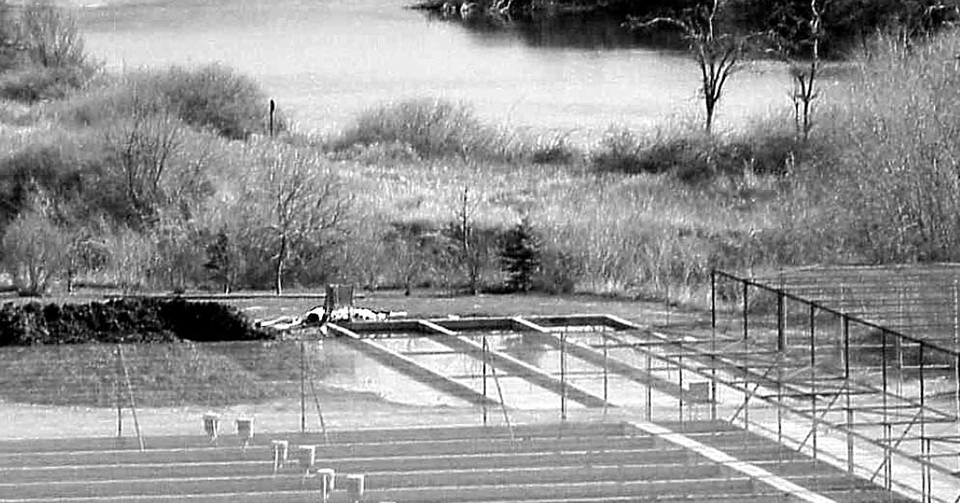
Phosphorus availability can be increased using feed additives. Phytin, also called phytic acid, is the storage form of phosphorus in seeds, e.g., corn, wheat, barley, soybeans. Phytin phosphorus is unavailable to fish and all other simple-stomached (monogastric) animals, including humans. The shift from animal proteins to plant proteins to lower total feed phosphorus levels has resulted in an increase in the level of phytin phosphorus in feeds. Phytin phosphorus passes through the gut of the fish and is excreted, thus contributing to phosphorus levels in hatchery effluents or ponds. The addition of phytase, a natural enzyme in seeds that releases phosphorus from the phytin complex as seeds sprout, increases phosphorus availability in fish. Phytase is produced by several companies and is added to poultry and swine feeds, increasing the cost of supplemented feeds by $5 to $7 per metric ton. Phytase activity increases with temperature to a peak at 50 to 55 degrees-C.
Its activity in fish varies with water temperature; it is more effective in warmwater fish (catfish) than in coldwater fish. Phytase can also be added to feed ingredients to release phosphorus from phytin prior to their being used in feeds, but this requires the addition of moisture and subsequent drying, increasing the cost of the ingredient.
Preliminary studies have suggested that the addition of citric acid to trout feeds increases phosphorus digestibility in grow-out size rainbow trout. However, feeding diets containing citric acid to fingerling rainbow trout lowered fish performance. This approach to increasing phosphorus digestibility in trout feeds, though promising, needs further research before it can be implemented. Citric acid increases phosphorus digestibility by lowering the antagonistic effect of calcium on phosphorus solubility in the intestine.
Low-phytate grains
Plant breeders have developed low-phytate forms of corn and barley, and it is likely that other grains can be similarly improved. In low-phytate grains, seeds have the same phosphorus content as regular grains, but the proportion of phosphorus present as phytate phosphorus is reduced by 75 percent. Initial testing in rainbow trout demonstrated that the apparent digestibility of phosphorus is significantly higher in low-phytate grains compared to regular grains. Species of fish that are fed diets high in grain products, such as channel catfish, are the most likely outlet for low-phytate grains in aquaculture.
High energy extruded diets
Another approach to reduce solids production and discharge in effluents is to increase the overall digestibility and energy content of the diet, and thus decrease the total amount of feed fed. As mentioned, very high-energy diets, over 30 percent total lipid, are being used successfully for Atlantic salmon and rainbow trout in Europe. In Idaho, dietary lipid levels in trout feeds have increased from 14 to 16 percent a few years ago to 22 to 24 percent today. Production of fecal solids can be further reduced by pelleting feeds using extruders or expanders which cook the carbohydrate portion of the feeds, eliminating the need to include indigestible binders in the feed. These feeds support improved feed conversion ratios compared to traditional steam pelleted feeds. Extruded and expanded feeds comprise an increasing portion of the aquaculture feed market in the United States.
Removal of solids
Modification of fish feeds such that resulting feces remain intact long enough for removal from the effluent is an area of current research. Rainbow trout farms often use quiescent zones, where fecal particles can settle without being re-suspended by the activity of fish. Solids are removed and conveyed to off-line settling basins for further settling and eventual removal for land application as soil amendments. However, feces tend to break-up into particles that are too small (<50 microns) to settle from the water column, and these small particles are carried out in hatchery effluents. If diets can be altered to produce intact, high-density fecal pellets, further reduction in total solids and perhaps dissolved nutrients in effluents could be achieved.
Clearly, there is no single approach to producing low-polluting (environmentally friendly) feeds for salmon and trout. Fish farms in the U.S. are fortunate that restrictions on feeds was not the approach chosen by regulators to lower nutrient levels in fish farm effluent water. Overall, phosphorus discharge from Idaho fish farms has been lowered significantly as a result of improved feed formulations, the use of quiescent zones, and by other management practices. Today, fish farms in Idaho are a relatively minor source of the phosphorus load in the mid-Snake River, the ultimate destination of fish farm effluents.
(Editor’s Note: This article was originally published in the April 2000 print edition of the Global Aquaculture Advocate.)
Now that you've reached the end of the article ...
… please consider supporting GSA’s mission to advance responsible seafood practices through education, advocacy and third-party assurances. The Advocate aims to document the evolution of responsible seafood practices and share the expansive knowledge of our vast network of contributors.
By becoming a Global Seafood Alliance member, you’re ensuring that all of the pre-competitive work we do through member benefits, resources and events can continue. Individual membership costs just $50 a year.
Not a GSA member? Join us.
Author
-
Ronald W. Hardy, Ph.D.
Hagerman Fish Culture
Experiment Station
University of Idaho
3059F National Fish Hatchery Rd.
Hagerman, ID 83332 USA
Tagged With
Related Posts
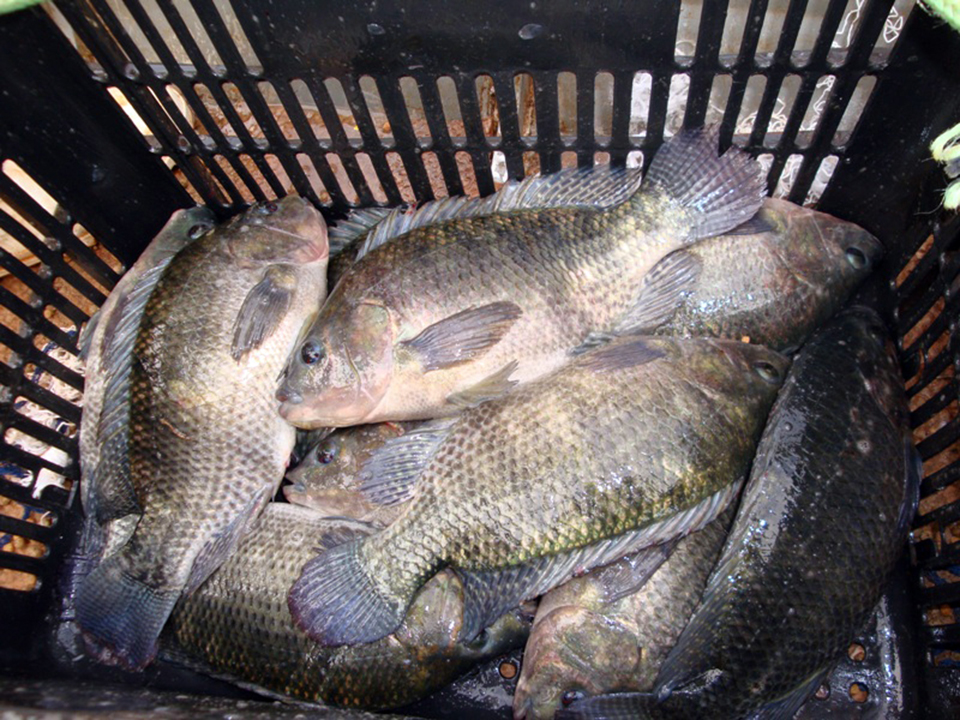
Health & Welfare
Brazilian researchers examine amino acids in Nile tilapia diets
Determining dietary requirements for tilapia requires precise formulation. Individual amino acids must be considered to establish well-balanced diets.
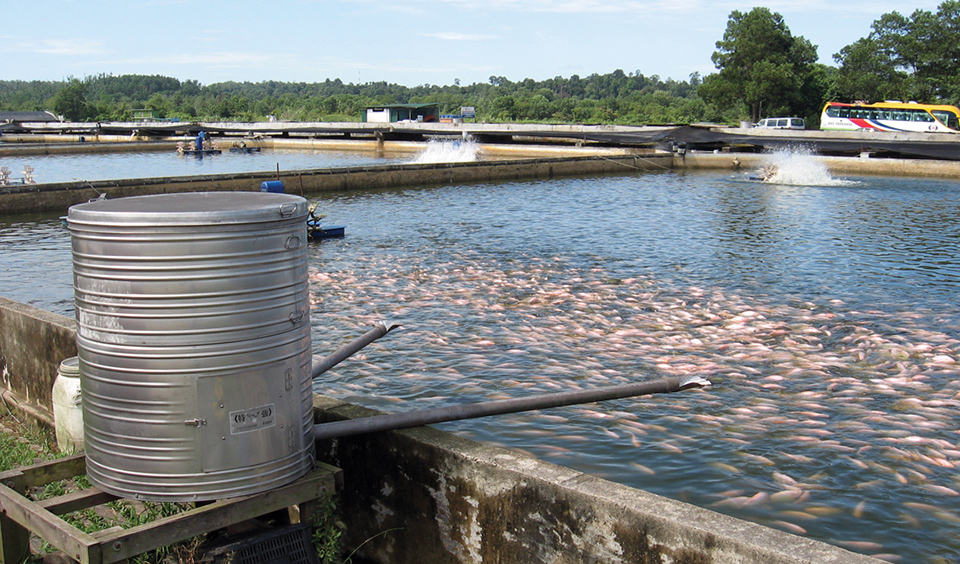
Aquafeeds
Food for thought: Feed management strategies, part 2
Production goals may call for specialized diets to meet market or other demands. An evaluation of feed management strategies can optimize culture conditions and maintain efficiency.
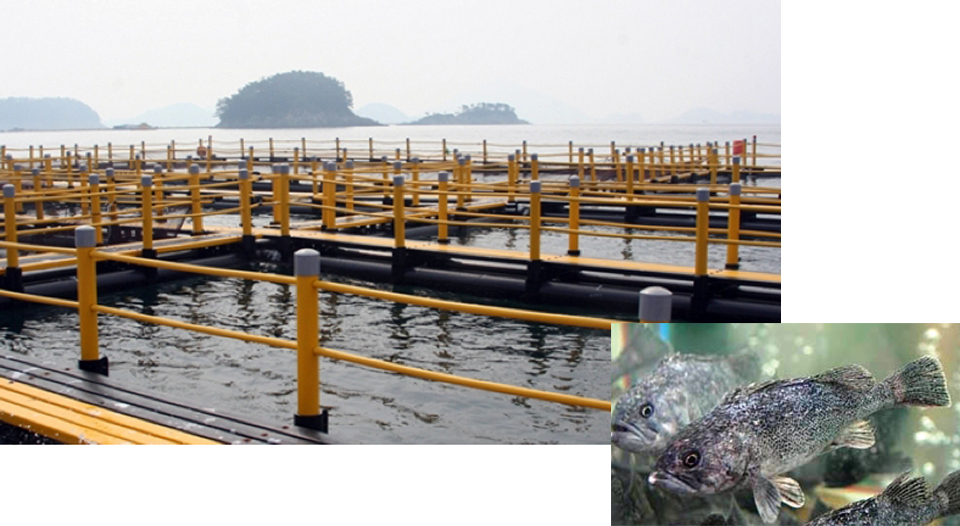
Responsibility
Korean rockfish production
Hatcheries produce Korean rockfish seedlings in indoor tanks for sorting and grading. The fish grow well at relatively low water temperatures in net cages.

Health & Welfare
A look at aquaculture genomics
Advances in genomics assist aquaculture science by deepening the understanding of adaptation, physiology and quantitative genetics.



